-
December 14, 2016 by Total Fire and Safety
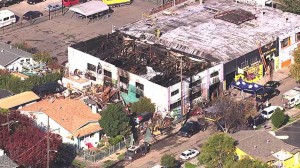 On December 2 in Oakland California, a deadly fire took 36 lives in a warehouse facility turned artist residence known as the Ghost Ship Artist Collective. It took four days for local firefighters to recover the scene. An absolute contributing factor? The lack of a sprinkler and fire alarm systems, blocked and inadequate fire exits and a lack of working fire extinguishers. On December 2 in Oakland California, a deadly fire took 36 lives in a warehouse facility turned artist residence known as the Ghost Ship Artist Collective. It took four days for local firefighters to recover the scene. An absolute contributing factor? The lack of a sprinkler and fire alarm systems, blocked and inadequate fire exits and a lack of working fire extinguishers.
In fact, the few extinguishers found among the bodies were inoperable. Officials say it is the highest number of fatalities in a structure fire in the U.S. in the last 13 years.
The tragedy shed negative light on the building owner, who refused to comply with fire codes and the state of the Oakland housing market, where people endured living in dangerous conditions since there was no other affordable alternative in the area. The city is also under scrutiny since the building had not been inspected for 30 years, and rightly should have been closed down.
But for those of us in fire safety, like Total Fire, the tragedy is a demonstration of the importance of our work, and how what we do saves lives.
The Looming Disaster
The Ghost Ship had been home to numerous fire hazards for some time and was no stranger to the authorities. The facility had been reported for tall weeds, mounds of garbage on the grounds, and illegal conduct of the community within, even though the space was not meant for residential use. The cause of the fire is still under investigation but at first, an old refrigerator was thought to be the cause.
The interior of the building was a chaotic mixture of improper electrical wiring and makeshift staircases, stacks of wood, furniture and other junk scattered around and wooden structures in progress. The fire started on the first floor, and people trying to evacuate had to weave through the inside clutter and climb a rickety, tight staircase to get out. People on the second floor were trapped by smoke and flames.
Many of the bodies were found as they were in their last moments–holding and hugging each other in fear.
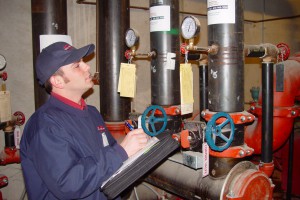
At Total Fire & Safety, we truly believe we do something more than just come to work, collect a pay check and go home. We play an important role in keeping our community safe!
Steven Holowka, our fire alarm division manager, puts it this way: “I tell my team to take the mindset that every building we take care of has someone you love in there. Would you want your loved ones being in a building that wasn’t properly taken care of? Would you feel okay if you one of your loved ones died in a building that wasn’t properly maintained?”
In the case of the Oakland tragedy, an inspection attempt was made as recently as last month when a code enforcement officer responded to complaints about piles of garbage. No one came to the door and the Oakland inspectors are not allowed to gain access to a building without permission.
The blaze started during a rave dance party, and the facility was not equipped or zoned for such a gathering. NFPA reminds us that in the case of nightclubs, theaters and auditoriums where large numbers of people gather, fires are the most deadly when the proper features and systems are not in place.
For theaters, night clubs, venues, etc. NFPA codes call for a considerable number of safety systems and features to be present for these structures, not just a single safety system or feature.
Saving Lives, a System at a Time
When building owners take shortcuts in service, look for the cheapest option or have the mindset that a fire like this could never happen to them, the consequences can be dire. That’s why we make sure we are doing our part in taking care of our customers and ensure that the systems they have onsite are adequate for their needs.
Our entire team, including our administrative employees, field technicians, managers and even our owner believes that it is our responsibility to do our job 100% because in the end we are protecting what matters most–people’s lives.
When we arrive at a facility we..
- TEST and INSPECT to make sure everything is in working order
- PROVIDE REPAIR/INSTALL SERVICE so everything is done correctly and ready to activate in an emergency
- and VERIFY that everything is up to code for the customer.
The fire at the Ghost Ship will rank among the Rhode Island Nightclub fire of 2003 and the Queen of Angels fire from 1958 as tragedies that could have been prevented or lessened considerably had the right life safety systems been in place.
As fire safety systems continue to improve, Jim Pauley of the NFPA warns that “we can’t be complacent just because numbers have gotten better.” It’s important that everyone responsible for the safety of those inside a facility have it properly inspected with well maintained and fully operational fire safety systems in place. Do you?
If you are unsure of whether your building is up to code, please don’t hesitate to contact us at Total Fire & Safety. We take our jobs seriously because we know what we do saves lives!
Category: Fire Alarm Monitoring, Fire code violation, Fire exits, Fire Extinguishers, Fire Extinguishers, Fire News, Fire Safety, Sprinkler Systems, Total Fire and Safety, Uncategorized Tags: fire and safety equipment, Fire Extinguisher, fire news, fire safety in the news, firesprinklerinspections, Ghost ship fire, importance of fire safety | Comments Off on The Ghost Ship Fire: 36 Lives Lost From Lack of Fire Safety Systems
-
August 17, 2016 by Total Fire and Safety
If you are an employer with ten or more employees, you are probably aware that OSHA requires you to conduct fire safety training and first aid training for your employees. But what is the value of this safety training? Does it really make a difference, or is it just a technicality?
The fact is, different ki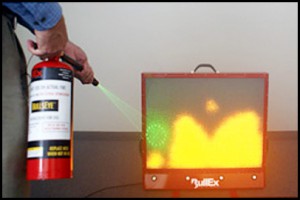 nds of occupational injuries and accidents, including fire safety ones, cost companies thousands and even millions of dollars a year. These include the direct costs of property damage and employee injury as well as the indirect costs of production down time and the intangible profitability loss from the lingering emotional effect on the morale of the employees. If you’ve ever wondered what that dollar amount would be for an injury at your jobsite, OSHA developed a calculator tool that you can use to see the cost of an injury at your business. As an employer, you are liable for the injuries or accidents that happen in your workplace, so making sure your employees are properly trained can save you money. nds of occupational injuries and accidents, including fire safety ones, cost companies thousands and even millions of dollars a year. These include the direct costs of property damage and employee injury as well as the indirect costs of production down time and the intangible profitability loss from the lingering emotional effect on the morale of the employees. If you’ve ever wondered what that dollar amount would be for an injury at your jobsite, OSHA developed a calculator tool that you can use to see the cost of an injury at your business. As an employer, you are liable for the injuries or accidents that happen in your workplace, so making sure your employees are properly trained can save you money.
The American Society of Safety Engineers (ASSE) has gathered extensive data on the effectiveness of quality safety training programs, and the results are promising. Some of their findings include:
- OSHA estimates that companies that implement effective safety programs can expect reductions of 20% or greater in injury and illness rates, as well as a return of $4 to $6 for every $1 invested in the programs.
- Workplace injuries will cost society $128 billion in losses this year, which equals one-quarter of each dollar of pre-tax corporate profits
- Indirect costs of injuries may be 20 times the direct costs — Indirect costs include: training and compensating replacement workers; repairing damaged property; accident investigation and implementation of corrective action; scheduling delays and lost productivity; administrative expense; low employee morale and increased absenteeism; poor customer and community relations
- Conducting effective safety training has been proven to lower your Workplace Modification Factor, which insurance companies use to assess businesses and determine their rates.
All in all, studies have proven that safety training programs can save your business money and grief. More ASSE reports on the returns on safety training investment can be found here.
The best safety training programs will be tailored to the type of injuries or accidents your employees are most likely to encounter. This is especially true in the realm of fire safety training, where different companies will need to know different things about the fires they are most likely at risk for in their working environment. As a result, all fire safety and first aid training programs are not alike. Choose the best fire safety training program or first aid training program for your company.
For more information on the specific needs of your business and how to achieve OSHA standards at a practical price, contact your local OSHA consultation office. Offering the right fire safety training and first aid training courses that prevent injuries will empower your employees to handle emergency situations well and prevent potentially fatal injuries. Don’t fail them! Look into Total Fire & Safety training today! For more information, contact Total Fire & Safety at 630-960-5060.
Category: Fire Extinguishers, Fire Safety Tags: Fire Extinguisher, fire extinguisher programs, fire extinguisher safety training programs, fire extinguisher training, fire safety training, first aid training, good fire training programs, OSHA fire training, safety training programs | Comments Off on How Fire Safety Training Pays
-
June 9, 2016 by Total Fire and Safety
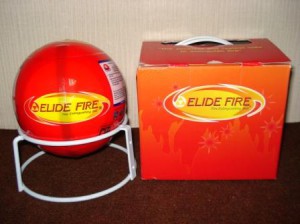 www.elidefire.com Elide Fire has a zany idea that might change the way that we fight fires in the future. These ball-shape extinguishers are like hand-held bombs that disperse the same chemicals that are found in normal fire extinguishers. To activate, you simply toss one toward the fire, and these little firefighters take care of everything. They are designed to activate within three seconds of being in contact with fire. They also work as alarms, emitting a loud sound when activated.
You may be thinking, could these really work to replace fire extinguishers as we know them? Although having red balls filled with chemicals sitting in your kitchen or near electrical plugs may clash with your color scheme, they would be able to activate even when you’re not at home. This feature could potentially save lives as well as property damage (as long as they never accidentally activate without fire, though. That would be a mess!).
The best part about this invention, however, is that it would be extremely easy to operate compared to a normal extinguisher. Using these extinguisher balls would be as simple as, well, tossing a ball. Even a child could do it (in a desperate situation, of course). Who knows, perhaps the fire training industry will soon have to create a simplified program that will more closely resemble pitching practice than fire safety training.
The Extinguisher Ball has a lifespan of five years, and is meant to be mounted or displayed in fire-prone places. Total Fire and Safety is keeping an eye on this new product for further developments, but in the meantime, those basic red fire extinguishers hanging on your wall are your best bet in the event of an actual fire. For more information on fire extinguishers and wireless fire alarms currently available, contact Total Fire & Safety at 630-960-5060.
Category: Fire Extinguishers, Fire Extinguishers, Fire News, Fire Safety, Total Fire and Safety, Trends Tags: alternative fire extinguisher, elide extinguisher balls, elide extinguishers, elide fire, Fire Extinguisher, fire extinguisher balls, fire extinguisher technology, fire fighting technology, fire news, fire rextinguisher bombs, fire safety news | Comments Off on Fire News: An Exploding Fire (Extinguisher?) Ball?
-
April 13, 2016 by Total Fire and Safety
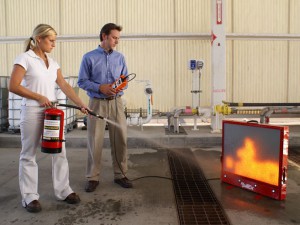
If your business has more than ten employees, they are going to need annual fire safety training. Some businesses rush to the least expensive program that will satisfy OSHA requirements, assuming that all training is the same; however, that’s simply not true. Fire safety training can vary in quality based on a number of factors, and many come with “hidden” fees that you may not be aware of. So what should you look for? Here are some important questions to ask before you book the training company.
1. What kind of course would you recommend? The course you need for your company should address the most probable emergencies that can occur at your facility. A training company worth its salt will tailor the course to your needs, surveying your business ahead of time to determine the most important content needed for your employees.
2. Who is teaching the course? Make sure the instructors are experienced professionals who know what real emergencies are like and how they occur. It’s even better if the instructor has experience with real-life emergencies. Nothing compares to the knowledge of a first responder who has faced countless fires and hazardous events. They can share personal stories, anecdotes and examples related to the training, which can make the class more interesting.
3. What will the course cover? Basic training courses cover how to use the fire extinguisher, but the most important thing employees should learn is WHEN to use the fire extinguisher. A good training course will focus on the importance of making fast and accurate, life-or-death decisions. Not only should your employees know how to fight fires, but also WHEN to fight the fire, and most importantly, when not to fight the fire. Evacuating and leaving it to the professionals is sometimes the best decision an employee can make.
4. Where will the training take place? Many fire safety trainings are performed outdoors, with a live burn in a pan that employees practice extinguishing. Although exciting, putting out a pan fire in a parking lot does not accurately simulate a realistic fire or emergency situation! Also, elements of the weather such as wind can affect the fire and unrealistically hamper the efforts of the employee trying to learn proper extinguishing techniques. It is much more effective to practice emergency procedures where they actually occur—inside the facility. With the help of digital technology, your employees can learn to extinguish the exact type of fire they would most likely face right at their worksite. This “on-the-spot” training also helps employees develop realistic evacuation plans and teach them to work as a team in an emergency situation.
5. Will there be extra costs involved with the equipment or the course materials? If the trainer is using “live burns”, or actual fires to practice extinguishing, you will need to have a burn permit and may incur any associated costs with setting up an outdoor space needed for the demonstration. If the training company uses your fire equipment for a live burn session, you will have to recharge them. You may not have budgeted for this unexpected, volatile cost, and it will vary based on how many turns each participant receives to extinguish the fire. The fire safety courses offered by Total Fire & Safety use high-tech, virtual simulators to practice extinguishing fires, which are versatile and allow more practice for each participant. These simulators feature virtual fire on a screen that responds realistically to the participant’s motions with the fire extinguisher. The indoor training gives each person multiple attempts with a full extinguisher every time until they feel confident with their firefighting skill. Compared to outdoor training, simulated training is more cost effective, accurate, completely green, and requires no messy clean-up or permit fees.
So before booking a company to perform fire safety training for your employees, ask these questions to make sure you receive your money’s worth for your employees and your business. No one can predict how an emergency will unfold, but the right training company can make sure your employees are not only prepared to fight a fire, but are adept at making quick decisions about whether or not it is safe to do so. For more information, contact the professionals at Total Fire & Safety at 630-960-5060.
Category: Fire Extinguishers, Fire Extinguishers, Fire Safety, Total Fire and Safety Tags: employee training, Fire Extinguisher, fire safety, fire safety training, fire training, fire training technology | Comments Off on Five Important Questions to Get Your Money’s Worth from Fire Safety Training
-
January 15, 2016 by Total Fire and Safety
Not only are fire extinguishers an important part of our everyday safety, but they are a part of our history as well. Have you ever wondered how this device became the little red powerhouses that keep our home and workplaces safe? Here are the highlights of fire extinguisher development throughout history.
- 200 BC- Ctesibius of Alexandria fashions a hand pump designed to deliver water to fires. It replaced the cumbersome technique of passing buckets from hand-to-hand to transport water to fire.
- The Middle Ages– Devices called ‘squirts’ were developed which worked like bicycle p
 umps. These were used on the 1666 Great Fire of London. umps. These were used on the 1666 Great Fire of London.
- 1819- Captain George Manby invents the first version of the modern portable fire extinguisher. It consisted of a copper vessel which sprayed a potassium carbonate solution using compressed air.
- 1912– An extinguisher model using carbon tetrachloride is mass-produced. It was suitable for liquid and electrical fires and was popular in motor vehicles for decades. However, the ingredients in this extinguisher were highly toxic, and some deaths did result in its use, particularly in small spaces.
- Mid-twentieth century– The modern fire extinguisher emerges, followed by various models using different ingredients. They generally use some kind of pressurized vessel to store and discharge the extinguishing agent.
Fire extinguishers have come a long way and remain our best defense against fire. It is important that everyone understand how to operate a fire extinguisher and to have proper fire extinguisher inspections. Fire extinguishers are required in commercial buildings, and it is also important to be up to code with your fire prevention. If you have questions about your building’s fire extinguisher requirements or would like more information about fire extinguishers, contact Total Fire and Safety at 630-960-5060.
Category: Fire Extinguishers, Fire Extinguishers, Total Fire and Safety Tags: Extinguisher, Fire Extinguisher, fire extinguisher history, firefighter history, history | Comments Off on Who Invented Fire Extinguishers?
-
August 18, 2015 by Total Fire and Safety
 1. There are different types of extinguishers for different fires. Make sure the fire extinguisher types in your building are the right type for the kind of fire that may happen, depending on the materials present in your business. 1. There are different types of extinguishers for different fires. Make sure the fire extinguisher types in your building are the right type for the kind of fire that may happen, depending on the materials present in your business.
2. To use a fire extinguisher, remember PASS. This acronym will walk you through the steps of using a fire extinguisher:
– Pull the pin. Hold the extinguisher with the nozzle
pointing away from you, and release the locking
mechanism.
– Aim low. Point the extinguisher at the base of the fire.
– Squeeze the lever slowly and evenly.
– Sweep the nozzle from side-to-side.
3. Fire extinguishers must be inspected by a licensed fire protection company on a monthly basis. This is an NFPA requirement. Total Fire and Safety has a 12-point fire extinguisher check that thoroughly assesses each portable fire extinguisher unit.
4. Fire extinguishers should be installed near exits. This will allow you to stay safely near an exit when using the extinguisher. If you do use it, keep a clear path to the exit and face your back to that exit. Evacuating all personnel is always the priority if a fire breaks out, so make sure you and everyone with you is within safe distance of an exit before attempting to extinguish the fire.
5. Employee training services are available. Total Fire & Safety has comprehensive training courses on many safety topics and fire equipment, such as CPR, machine safeguarding, emergency preparedness, and many others. They offer OSHA and AHA compliance courses in these topics also.
For more information about fire extinguishers in businesses, you can contact Total Fire and Safety at 630-960-5060.
Category: Fire Extinguishers, Fire Extinguishers, Fire Safety, Total Fire and Safety Tags: business, employee training, Extinguisher, Fire Extinguisher, fire extinguishers, fire safety, fire safety tips, safety training | Comments Off on 5 Things Businesses Should Know About Fire Extinguishers
-
June 24, 2015 by Total Fire and Safety
(This is the first in a two-part series about suppression systems.)
If you are in the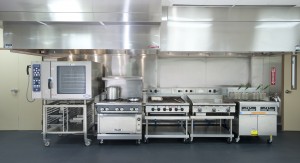 restaurant business or have industrial paint booths, you are probably no stranger to commercial fire suppression systems. restaurant business or have industrial paint booths, you are probably no stranger to commercial fire suppression systems.
Suppression systems are tailored to a specific fire hazard such as cooking equipment or industrial chemicals. They consist of an alarm system as well as sprinklers to deal with specialized fires. While kitchens and industrial paint booths comprise the bulk of suppression systems, there are also specialized applications for computer and process control rooms, laboratories, libraries, museums, robotic systems, tape storage libraries, and telecommunications facilities.
For Commercial Kitchens
Kitchen suppression systems are very important because of the continuous, dangerous combination of high temperatures and flammable oils. Since these fires cannot be extinguished with water, they must be doused with special chemicals. A fire safety service such as Total Fire and Safety can install a fire suppression system that includes commercial fire sprinklers to release the right chemicals at the right time to douse any dangerous kitchen fire.
Systems need to be inspected every six months to keep up with NFPA standards. Total Fire and Safety can also provide thorough, efficient inspections, and can automatically remind your business when it’s inspection time.
For Industrial Paint Booths
Paint booth fire suppression systems are installed around spray-painting booths which use hazardous, flammable chem icals. The enclosed nature of the booths requires a separate fire suppression system to contain the fire. The suppression system disperses an extinguishing agent when a fire is detected. icals. The enclosed nature of the booths requires a separate fire suppression system to contain the fire. The suppression system disperses an extinguishing agent when a fire is detected.
Since paint booths can be used for a variety of jobs that may involve different types of paints and chemicals, a professional assessment must be made to determine what kind of extinguishing agent will be used in the suppression system. Total Fire and Safety is experienced with all types of industrial paint booth suppression systems and can provide all maintenance and inspection services to keep your company in compliance. Total Fire also offers 24 hour emergency service for these systems so that any problems are resolved quickly with minimal downtime for the facility. For more information on Total Fire & Safety’s fire suppression installation, inspection and maintenance services, contact us or call 630-960-5060.
Category: Fire Extinguishers, Fire Safety, Total Fire and Safety Tags: computers, fire safety technology, fire sprinkler, fire suppression, sprinklers, suppression systems, Total Fire and Safety | Comments Off on What is a Commercial Fire Suppression System?
|

|
|
|
|
|
|
 On December 2 in Oakland California, a deadly fire took 36 lives in a warehouse facility turned artist residence known as the Ghost Ship Artist Collective. It took four days for local firefighters to recover the scene. An absolute contributing factor? The lack of a sprinkler and fire alarm systems, blocked and inadequate fire exits and a lack of working fire extinguishers.
On December 2 in Oakland California, a deadly fire took 36 lives in a warehouse facility turned artist residence known as the Ghost Ship Artist Collective. It took four days for local firefighters to recover the scene. An absolute contributing factor? The lack of a sprinkler and fire alarm systems, blocked and inadequate fire exits and a lack of working fire extinguishers. Facebook
Facebook
 Instagram
Instagram
 LinkedIn
LinkedIn








